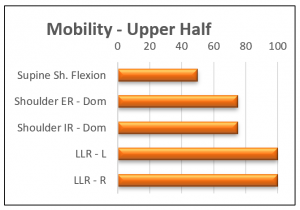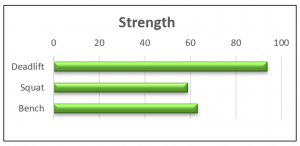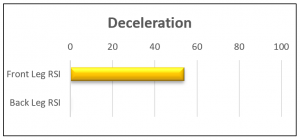
Colm O’Shea, Graduate Senior at Newberry College, joined us over summer and participated in our Summer Throwing Program. Gearing up for his last season of college baseball, it was important for Colm to improve his strength and power to gain additional velocity while also improving his motion throughout his delivery. His time in-house commenced with a complete assessment, including a movement screen, strength and power testing, and a mechanical breakdown of his delivery combining both motion capture and video analysis. The 6’6” 240 lbs. reliever sat 84-86 last spring. Recently, he has been sitting 88-89, touching 90 mph.
How did he do it?
Needless to say, Colm walked through the doors this summer and put the pedal to the metal.
It’s every pitcher’s goal to throw harder. And, while all pitchers are not built the same, accomplishing their goals in the 3-month summer program does not happen in the same time frame for everyone. Addressing and correcting the lowest hanging fruit puts them in a greater position to succeed. In Colm’s case, several topics stood out in a few of the numerous variables we evaluated in his baseline assessment.
Let’s take a deep dive!
Movement Screening
The mobility portion of the assessment is essential in helping detect movements that may be limiting an athlete from getting into more efficient positions on the mound. Colm’s lower half mobility was more than sufficient, but his upper half mobility is what really needed attention.
Tight Pec Minor and Lats: By testing shoulder flexion in the supine position, we were able to gauge the tissue quality of the pec minor and analyze the range of motion in Colm’s lats. Both the pecs and lats are vital internal rotators that are pivotal in a pitcher’s ability to properly engage their scap as they are riding down the slope. This limits the ability of just how efficiently a pitcher can get overhead.
ER / IR: In Colm’s case, his tight pecs and lats restricted how much range of motion he had in his shoulder. External rotation, also known as Layback, is the pre-stretch/cocking position that takes place from foot plant into release. A lack of layback could lead to a very tense arm action throughout the throw. The internal rotation of the glenohumeral joint is responsible for how well a pitcher can decelerate their arm after release.

Strength & Power
After the completion of the mobility assessment, we test for strength and power production. In Colm’s case, he presented with sufficient lower half posterior strength (glutes and hamstrings) but lacked in lower half anterior (quads) and upper body strength. Prescribing him the proper strength movements along with tempos and bar speeds was essential in his progression throughout the summer.

Upper Body Power: Our Proteus Motion allowed us to accurately measure Colm’s upper body power and acceleration in the frontal and transverse planes The results below reveal inefficient power production which required further development.
Note: Since most colleges do not have a Proteus Motion, athletes are typically unfamiliar with the movements and how to efficiently produce force in this part of the assessment. Thus, we generally re-test 1 week after prescribing these movements in their program to get a more accurate reading.

Deceleration: A pitcher’s ability to decelerate the body at foot plant is extremely important in order to possess both efficient front foot stability and lead leg block. Based on Colm’s “Front Leg RSI” results from his assessment, his plyometric ability was a Phase 2. In other words, he was able to stabilize quickly, but was poor in turning it back around (amortization) into power going back up the chain.

Mechanical Delivery
To conclude Colm’s assessment, the final piece was his mechanical breakdown with motion capture and video analysis. Along with the video, having motion capture data is a great tool to give us a better visual of things that are tough to see with the naked eye such as angular velocities. This provides us with a better understanding as to what is really occurring throughout his delivery.
We will now go over what he did well and what needed to be improved.
Things he did well…
-
- Glove-Side Position/Timing: Proper timing of the glove-side delays the front side and trunk from rotating early. This puts the pitcher in a position sequence properly as his upper half is closed and lower half opens at foot plant.
- Hip Shoulder Separation @ FP: Colm “closes the gap” very well which is where his torso accelerates towards his hips going into release. This slingshot effect increases rotational capabilities throughout the pitcher’s delivery as they fire the ball towards the plate.
Things he needed to work on…
-
- Late arm and max shoulder ER at foot plant: Due to his upper half mobility issues, Colm had both a late arm and limited layback in his shoulder. His late arm caused poor timing for his scap load and his lack of external rotation caused a very muscled up arm action throughout the throw.
- Lead Leg Foot Position at foot plant: A pitcher cannot have a stable base without having a stable front foot at foot strike. A sufficient foot position at landing typically leads to better knee extension and transfer of energy through release.
How we addressed his movement deficiencies…
Following the completion of the mechanical assessment, we prescribed throwing correctives in conjunction with his strength and mobility work in–gym to help correct overall movement patterns on the mound. Below is a summary of Jack’s movement drills to help address his deficiencies:
-
- Walking Torque: Used to help with linear component to all upper body mechanics and front foot position @ FP.
-
- Figure 8 Rocker: Used to help feel a loose arm and shoulder to eliminate muscling up while also putting the trunk in a stable position @ FP.
-
- Step Back Drill: Used to improve shifting COM (Drifting) and front foot position @ FP.
-
- Step Behind: Used to help with glute engagement and better sequencing the upper and lower half.
Summary
Colm came in this summer with a purpose to improve in all aspects of his performance and he did just that. Based on his velocity jump it’s tough to deny the work that was put in. He entered our facility coming off a season where he was 84-86. In his return to campus, he is now sitting 88-89, T 90.
Improving his strength helped him hold tension longer and increasing power output allows him to now move more explosively down the mound. Improving front leg deceleration allowed Colm to stay more connected into the ground and rotate over and around his front hip more effectively. The last piece of the puzzle was correcting his upper half mobility issues by opening his pecs, lats, and shoulder which allowed him to both accelerate and decelerate his arm more efficiently.
As he continues his fall season with an improved frame, added velocity, and cleaner mechanics, we look forward to what the future holds for Colm.
Best of luck big man!
By Niko Leontarakis (Director of Pitching at RPP Baseball) and Nunzio Signore
You live too far to train with us in-house at RPP? You can now train with us on a REMOTE basis.


